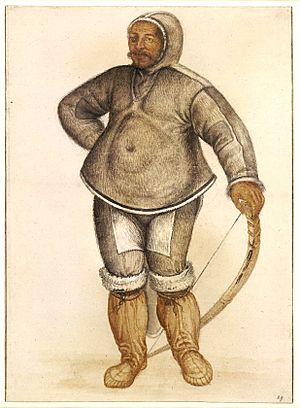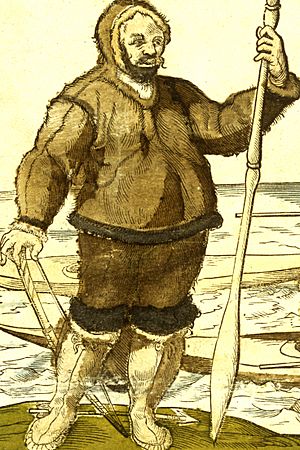Kalicho facts for kids
Quick facts for kids
Kalicho
|
|
|---|---|

Kalicho in a picture by John White
|
|
| Born | c.1550 Baffin Island, Nunavut, Canada
|
| Died | 8 November 1577 (aged approx. 25-26) Bristol, England
|
| Cause of death | Complications stemming from broken ribs |
| Nationality | Canadian |
| Known for | Travelling to Britain |
Kalicho was an Inuk man from the Frobisher Bay area of Baffin Island, Nunavut, Canada. He traveled to England with Sir Martin Frobisher in 1577. He journeyed with an Inuk woman named Arnaq and her baby, Nutaaq. They were among the first Inuit and Indigenous people from North America to visit England. Their journey was well-recorded during the Tudor period.
Kalicho's Journey
Kalicho was probably born around Frobisher Bay on Baffin Island in the mid-1500s. He lived as a hunter and fisher until July 19, 1577. On that day, the English explorer, Sir Martin Frobisher, met him. George Best wrote about Kalicho's experiences in 1578. Frobisher was leading a trip for the English Cathay Company of London. This company wanted to find a Northwest Passage through America to the Pacific Ocean. Their main goal was to start direct trade between England and Cathay (China).
Why Kalicho Traveled
Frobisher first took Kalicho and Arnaq as a way to get back five Englishmen. These men had disappeared during Frobisher's trip the summer before. When it became clear that a prisoner exchange was not possible, Frobisher decided to take the Inuit people to England. He planned to show them to Queen Elizabeth I. He also hoped to teach them English. This way, Kalicho could help as a guide and interpreter on future voyages.
Arriving in England
Kalicho, Arnaq, and Nutaaq caused a lot of excitement when they arrived in the English port of Bristol. This was at the end of September 1577. Many pictures were made of them. The Flemish artist Cornelis Ketel painted Kalicho five times. Other artists also drew their likenesses. Doctors also examined them, and these examinations were well-documented.
In Bristol, Kalicho stayed in private rooms. He even ate at the Mayor's house at least once. Kalicho showed off his skills in the harbor. He demonstrated kayaking and duck-hunting. Large crowds came to watch him. People remembered and described these displays decades later. William Adams' Chronicle, written around the 1640s, mentioned the expedition:
They brought likewise a man called Callicho, and a woman called Ignorth : they were savage people and fed only upon raw flesh. The 9th October he rowed in a little boat made of skin in the water at the Backe, where he killed 2 ducks with a dart, and when he had done carried his boat through the marsh upon his back: the like he did at the Weir and other places where many beheld him. He would hit a duck a good distance off and not miss. They died here within a month.
Kalicho passed away in Bristol on November 8, 1577. A doctor named Edward Dodding performed a postmortem. He believed Kalicho's death was due to broken ribs. This injury likely happened when he was first met in July. After his death, Kalicho was buried at St Stephen's Parish Church on November 8. The church record described him as a 'heathen man'.
Kalicho's Lasting Impact
Kalicho is the most well-known Indigenous person to visit England before the 1600s. At least one of his portraits, along with one of Arnaq, was given to Queen Elizabeth I. These artworks hung in Hampton Court Palace until at least the late 1600s. While Ketel's paintings are now lost, drawings by the English artist John White survived. The British Museum bought these drawings in 1866.
The pictures of Kalicho, Arnaq, and Nutaaq became the basis for many prints. These prints were shared across Europe. They helped shape how Europeans understood the Inuit, who were called Eskimos at the time. This was during the early modern period. One famous example is Lucas de Heere's 'Portrait of Inuit man, 1577'. This was part of his important book about different peoples, Theatre de tous les peuples et nations de la terre.


